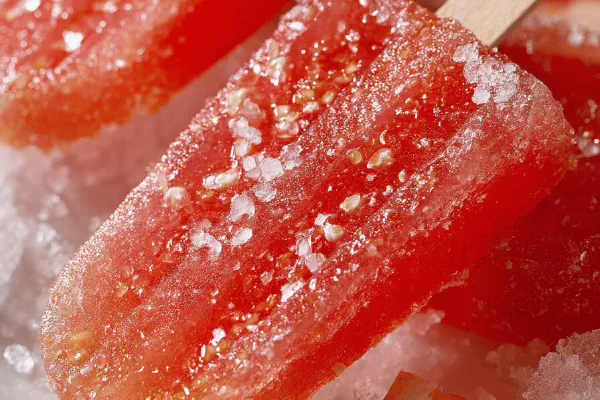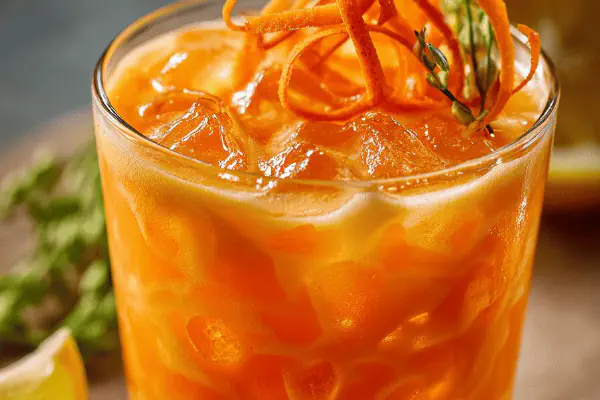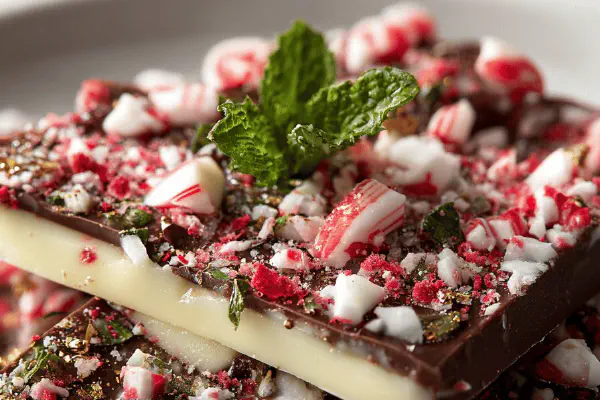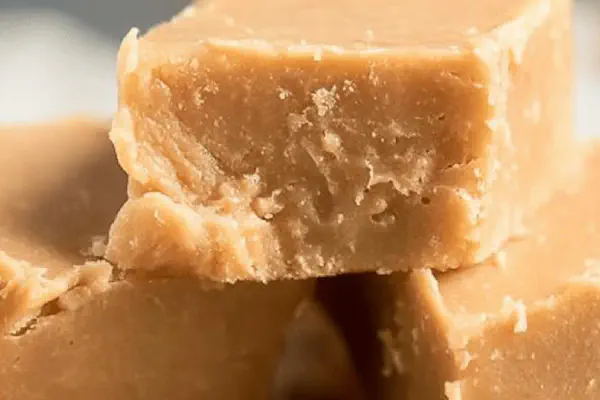Butterscotch Snow Taffy Remix
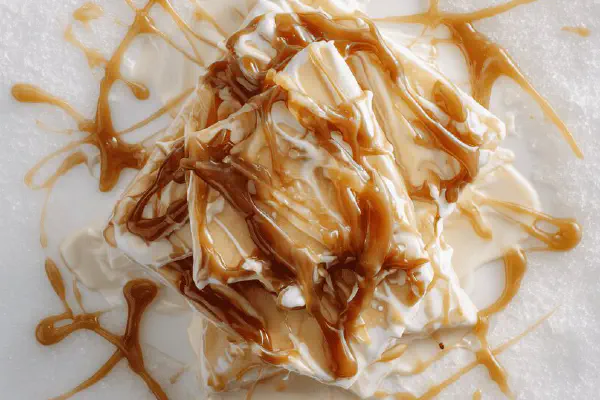
By Emma
Certified Culinary Professional
Ingredients
- 400 ml (1 3/4 cups) granulated sugar
- 100 ml (1/3 cup) golden agave nectar
- 120 ml (1/2 cup) aged dark rum
- 25 ml (1 1/2 tbsp) unsalted vegan butter
- 1 ml (1/4 tsp) smoked sea salt
- 150 ml (2/3 cup) water
- Wooden coffee stir sticks
- Fresh, clean snow or crushed ice packed firm
About the ingredients
Method
Preparation
- Dust off snow, pack tightly in a shallow tray or metal pan nearby. Snow must be fresh, dry, white. No yellow or melting mush — ruins texture.
Syrup mix
- In a heavy bottom saucepan, toss sugar, agave, rum, vegan butter, smoked salt. Use medium-low heat to start so sugar dissolves gently. Stir slowly, not vigorously; prevents graininess.
- Watch mixture carefully. You want it to bubble softly, not wild crashing — sounds change from sharp crackle to mellow hiss. When faint amber tint appears, ready for final boil.
- Add the water now. It may sputter. Don’t panic. Scrape down sides with wet pastry brush if crystals form to avoid recrystallization.
Cooking to temperature
- Fit candy thermometer, clip firmly so sensor sits in syrup without touching pan's bottom. Keep heat medium; too hot scorches; too cool drags timing.
- Cook until thermometer hits 119 °C (246 °F). Don't rely solely on time; temps vary. Visual cues: syrup will thicken, bubble volume size getting bigger, color a soft gold.
- Remove quickly from heat. You want syrup still pourable but close to “soft crack” stage; will harden quickly on cold snow.
Pouring and pulling
- Pour in thin, steady streams over snow, covering 20–30 cm strips. Work fast, syrup firms in seconds. Use sticks to lift sticky threads immediately before set.
- Twirl sticks to roll threads into gooey, shiny ropes. If you wait too long, syrup becomes brittle shards—still good, but no fun to chew.
Tips and troubleshooting
- No thermometer? Use cold water test: drop a spoonful into chilled water, it should form brittle threads that snap but bend slightly.
- If syrup crystallizes or grainy, probably stirred too much after boiling or dusted with sugar dust — start fresh.
- Ran out of snow? Crushed ice packed tight can work but syrup will melt faster. Use plate lined with parchment and freeze an hour minimum.
- Can swap rum for dark whiskey or spiced brandy, less booze just heat extract. Butter replacement needs fat, coconut oil works but adds flavor twist.
- Store pulled taffy in airtight container to keep chewiness. Leftover syrup can be reheated slowly but watch for burn.
Eating
- Sticky, sweet, slightly smoky, with warmth from dark rum. Cold snow cools rapidly creating thin sugar threads that snap then melt on tongue.
- Pair with black coffee or sharp cider in cold weather. A childhood flashback if you grew up northern winters or street fairs.
Cooking tips
Chef's notes
- 💡 Use only fresh dry snow for pulling syrup. Wet or melting flakes ruin texture — syrup melts too fast, sticky threads fail to form. Pack firmly in shallow tray nearby your stove; the cold surface sharpens sugar quickly. Watch syrup color closely — amber tint means ready for final boil; too dark burns, too light lacks depth. Timing’s everything here; pour right away with steady thin streams. Stir gently, no fast whipping. Sugar can recrystallize if you’re too aggressive after starting boil.
- 💡 Thermometer placement matters. Clip sensor firmly in syrup but no bottom contact to avoid false highs. Keep medium heat; high scorches edges, low slows cooking, risking crystal growth. Target temp 119°C (246°F) for soft crack stage. Visual cues help too: larger bubbles, syrup thickens, color moves gold but not brown. If no thermometer, cold water test works — spoon in chilled water forms brittle but bendable threads. Watch sounds — starts sharp crackle, then mellow hiss signals near done.
- 💡 Butter choice tweaks flavor and texture. Vegan butter solid blocks best; margarine or oils make syrup oily or soft. Butter balances sugar sharpness and gives chewiness. Salt isn’t optional; smoked sea salt adds subtle smoky note to match rum’s vanilla warmth. Start with small amount; it cuts sweetness but too much masks candy’s delicate aroma. Agave nectar replaces corn syrup here. Measure carefully since sweeter; too much though makes sticky mess or alters final texture unpredictably.
- 💡 Pulling taffy needs speed and dexterity. Pour syrup immediately over snow in thin 20–30cm strips. Use dry wooden coffee stir sticks, not flimsy or damp. Lift threads fast before syrup sets brittle—else they shatter to shards, still edible but no chew. Twirling sticks rolls sticky strands into shiny ropes. If syrup cools too long before pulling, candy becomes harder, less pliable. Work near snow tray to keep hands warm but avoid sweating sticks. Leftover syrup reheated gently; avoid hard burns or graininess from over stirring.
- 💡 No snow? Use crushed ice packed firmly on parchment-lined plate frozen minimum one hour. Snow density key to rapid syrup cooling. Ice melts faster, candy sets quicker but sticky threads won’t hold as well. Try alternatives like spiced whiskey or bourbon for different spirit flavor profiles. Coconut oil replaces butter in pinch but expect flavor shift. Store pulled taffy in airtight container; moisture loss hardens candy. Clean pans fast by soaking while hot sugar still soft—scraping dried syrup scratches metal.
Common questions
How to know syrup reached soft crack stage?
Temp target 119°C. Visual signs bubble size bigger, color soft gold. Sound changes sharp crackle to mellow hiss. No thermometer? Cold water test — syrup drops form brittle but flexible threads.
Can I substitute rum with other alcohols?
Yes, dark whiskey or spiced brandy work. Less alcohol means milder flavor. Heat extracts spirit notes differently. Avoid plastic container storage after mixing alcohol; solvents can leach unwanted tastes.
What to do if syrup crystallizes?
Usually from stirring too vigorously after boiling or sugar dust falling back in. Solution: start fresh batch. Keep stirring slow on low heat, scrape sides with wet brush to dissolve sugar crystals preventing recrystallization.
How to store pulled taffy?
Airtight container best to keep chewiness. Leftovers reheat gently to use again but watch burn risk. Store in cool dry place. Avoid plastic if alcohol infused candy stored longer—use glass or ceramic. Left long time taffy hardens from moisture loss.
